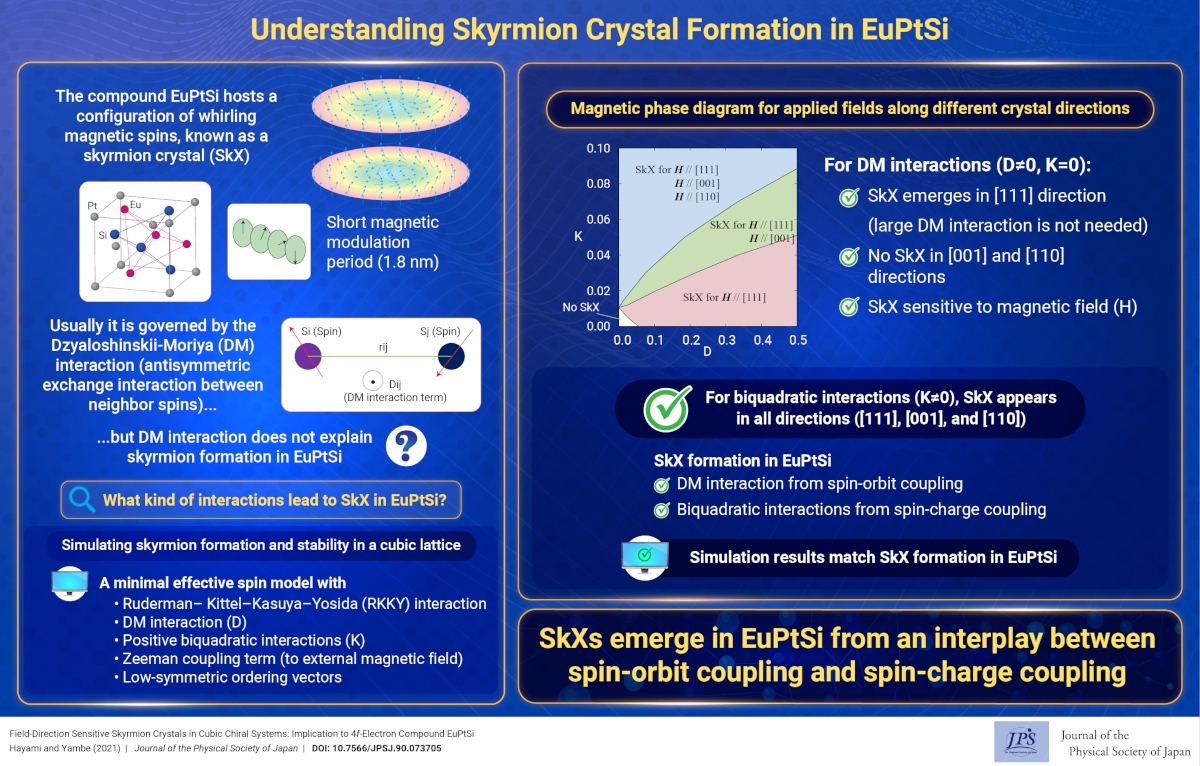Understanding Skyrmion Crystal Formation in EuPtSi
© The Physical Society of Japan
This article is on
Field-Direction Sensitive Skyrmion Crystals in Cubic Chiral Systems: Implication to 4f-Electron Compound EuPtSi
(JPSJ Editors' Choice)
J. Phys. Soc. Jpn.
90,
073705
(2021)
.
We theoretically demonstrate that the interplay between the spin-charge and spin-orbit couplings in itinerant magnets stabilizes field-direction sensitive, short-period skyrmions. Our results can aid in engineering short-period skyrmions.

Magnetic skyrmions with swirling topological spin textures are of significant interest owing to their peculiar magnetic, transport, and optical properties. In magnetic materials, skyrmions usually appear in a periodically ordered state, which is referred to as the skyrmion crystal (SkX). The SkX can be considered as a multiple-qorder described by the superposition of multiple spiral waves. The SkX was originally discovered in 2009 in d-electron compounds like MnSi, where the Dzyaloshinskii–Moriya interaction plays an important role. Recently, SkXs have been observed in centrosymmetric magnets via other mechanisms, such as frustrated exchange interactions and/or multiple-spin interactions in itinerant magnets. The resulting difference due to the individual origins appears in the magnetic modulation period of the SkXs, with the original mechanism usually leading to much longer magnetic periods than those of the latter ones. Specifically, a small skyrmion induces a large emergent magnetic field, and hence engineering small skyrmions is relevant for future spintronics applications, as they may potentially aid in realizing energy-efficient devices based on high density topological objects.
The itinerant chiral antiferromagnet EuPtSi is the first f-electron compound with a noncentrosymmetric lattice structure found to host a SkX with a small magnetic period. The origin of the SkX in EuPtSi is not explained by the conventional mechanism based on the Dzyaloshinskii–Moriya interaction, as the magnetic periods and the magnetic-field-direction dependencies of the SkXs are different from those found in other noncentrosymmetric magnets. Therefore, we need to consider other mechanisms that have not yet been theoretically clarified. Understanding the origin of short-period SkXs in noncentrosymmetric itinerant magnets found in EuPtSi is crucial in enabling small skyrmion engineering for practical applications.
In this study, we theoretically investigated the origin of SkXs in f-electron compounds by constructing a new model based on EuPtSi. We discovered the following two important elements in inducing a field-direction sensitive SkX with a small magnetic period: (1) the multiple-q superpositions of the spirals with low-symmetric ordering vectors and (2) the synergy between the long-range Dzyaloshinskii–Moriya interaction arising from the spin-orbit coupling and the biquadratic interaction arising from the spin-charge coupling in itinerant magnets. We demonstrated that the theoretical model which satisfies the two conditions accurately describes the SkX physics in EuPtSi through unbiased annealing simulations. Our study provides a reference for both engineering short-period SkXs and for exploring further skyrmion-hosting materials in noncentrosymmetric itinerant magnets.
(Written by Satoru Hayami on behalf of all authors.)
Field-Direction Sensitive Skyrmion Crystals in Cubic Chiral Systems: Implication to 4f-Electron Compound EuPtSi
(JPSJ Editors' Choice)
J. Phys. Soc. Jpn.
90,
073705
(2021)
.
Share this topic
Fields
Related Articles
-
Higher-Order Topological Phases in Magnetic Materials with Breathing Pyrochlore Structures
Electronic structure and electrical properties of surfaces and nanostructures
Magnetic properties in condensed matter
Mathematical methods, classical and quantum physics, relativity, gravitation, numerical simulation, computational modeling
2025-4-7
A simple example of a higher-order topological phase, in which the symmetry decreases step-by-step from the bulk to the corner, is realized in a magnetic system with a pyrochlore structure and is characterized by a series of quantized Berry phases defined for the bulk, surface, and edge.
-
Existence of Chiral Soliton Lattices (CSLs) in Chiral Helimagnet Yb(Ni1-xCux)3Al9
Magnetic properties in condensed matter
2025-4-1
Our study examines the magnetic structure of the monoaxial chiral helimagnet Yb(Ni1-xCux)3Al9, providing first direct evidence of the formation of chiral soliton lattice state.
-
Understanding Pressure-Induced Superconductivity in CrAs and MnP
Magnetic properties in condensed matter
2025-3-10
This study reviews existing research on the pressure-induced variation of magnetic properties of transition metal mono-pnictides like CrAS, MnP, and others, aiming to understand the unconventional superconductivity observed in CrAs and MnP.
-
Symmetry and AI: Building the Future of Physics Simulations
Magnetic properties in condensed matter
Measurement, instrumentation, and techniques
2025-2-18
Generative artificial intelligence (AI) has gained considerable attention in scientific fields. By embedding physical symmetry into AI before training, we created a faster and lighter model. Scaling improves the accuracy and unlocks the potential of physics research and applications.
-
Triangular Lattice Magnet GdGa2: Spin Cycloids and Skyrmions
Cross-disciplinary physics and related areas of science and technology
Electronic transport in condensed matter
Magnetic properties in condensed matter
2025-2-3
Careful measurements were conducted on the hexagonal magnet GdGa2 to reveal the experimental signatures of ultrasmall spin cycloids and of a potential Néel-type skyrmion lattice phase induced by a magnetic field.




